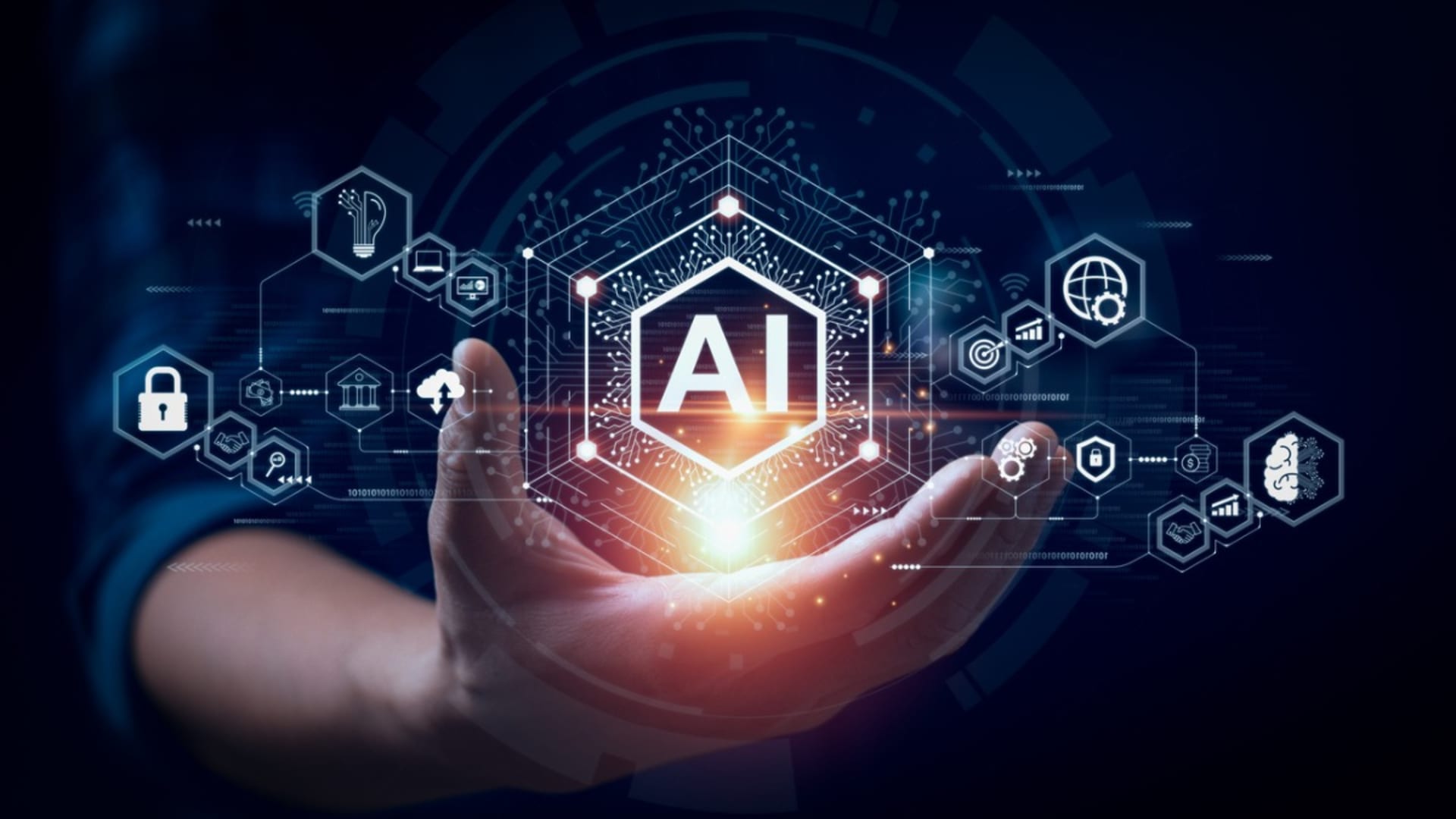Innovation is never achieved by standing still and value is never generated by not taking risks. The evolution of the global business market has been intensively powered by technology—and now, technology is advancing itself through Artificial Intelligence.
For an organization to get the most business value out of AI solutions, it is critical to understand what AI actually is, its impact on the business world, how it creates that value, and how to implement an AI strategy. The goal of this whitepaper is to guide business leaders throughout all these topics, offering key advice and insights on artificial intelligence solutions and the role of IT Outsourcing Services in the matter.
AI & Business in 2021
In 2021, AI is as trendy as it has ever been. This has brought a lot of relevance to the topic, but also many misconceptions and uncertainties. However, it must be said that the value-driving capabilities of artificial intelligence are undeniable. Most industries, if not all, are already benefiting from this technology. And at the same time, companies have witnessed dramatic changes in the business landscape.
Now, implementing a successful AI strategy comes up as a difficult challenge for many organizations. But, when done properly, the returns are tremendous. With today’s market being more tech and talent-driven than ever, leveraging business strategies on cutting-edge technologies seems to be the only way to remain competitive. We want to provide you with the necessary knowledge to understand, adopt, and run AI solutions in a business context, while also getting the most value out of them.
Artificial Intelligence is an often misunderstood field, especially by companies that are not too familiarized with its applications. Some people believe AI is about human-like robots and magical code, while others think it is just too complicated to get into. However, the truth is that we are at a stage where AI is easy to understand, access, and implement at a basic level—which makes it all that more powerful for businesses.
In general terms, AI is defined as the ability of machines to perform human-like tasks by identifying patterns from large datasets. The field originated in the mid-1950s and its capabilities have expanded at an exponential rate.
Today, it is common knowledge that computers have far surpassed human skills in many domains. This has strongly attracted the attention of innovative businesses looking to scale the efficiency of their operations. But the success and value generated by any AI project require a clear understanding and smart expectations from the entire organization, particularly the C-level.
The Trident of AI Technologies for Business
These three key concepts are the starting point of any business strategy that uses artificial intelligence.
Artificial Intelligence
Artificial Intelligence studies the automation of smart behavior to tackle business problems as a human would.
AI computers feed on data that allows them to define context, identify variables, reason, and take action.
Machine Learning
Machine learning describes the various processes that enable computers to learn from data without explicit rules.
Today, ML is most commonly used to reveal hidden relationships in input data and pull insights from them.
Deep Learning
Deep Learning simulates brain neurons using “nodes”, analyzing data through thousands of layers.
When it comes to understanding insanely large amounts of data, DL outperforms any other AI algorithm.
A Closer Look at AI, Machine Learning, and Deep Learning
- AI: A definitionSimply stated, Artificial Intelligence is a branch of the IT Industry that studies the automation of intelligent behavior. The goal of an AI program is to tackle problems independently, similar to the way humans do. This means making data-driven decisions in response to the context and its variables by sensing, reasoning, and taking action. There can’t be AI without data.Modern AI machines are based on a multi-disciplinary approach that encompasses mathematics, computer science, economics, statistics, and psychology. Common applications like virtual assistants, e-commerce websites, chatbots, and social media use powerful AI algorithms to provide the experiences most customers are now used to.
- Machine LearningMachine learning (ML) is a collective term that describes the various processes that enable a machine to learn from data without following explicitly programmed rules. In other words, it learns from working with whatever data is available. Today, it is most commonly used to reveal hidden relationships in input data and pull insights from them.What’s really interesting about ML algorithms is that they improve themselves over time by accesing more data. Basically, the more data you feed them, the better results it will produce—just as long as it doesn’t become overfitted. Businesses often use machine learning to solve three types of problems: Classification (identifying objects, pictures, audios, etc), Prediction (forecasting outcome probabilities), and Generation (creating objects, text, images, audio, etc).
- Deep LearningIn recent years, Deep Learning (DL) has taken AI to a whole new level. Based on neuronal networks technology, DL places a family of algorithms throughout hundreds or thousands layers—hence the name “deep”. When it comes to understanding insanely large amounts of data, DL instantly outperforms any other AI algorithm.The way neuronal networks work is based on the human brain. They use closely-connected processing elements that simulate brain neurons, known as “nodes”. These gather data from the environment or from other nodes, process it, and pass it on to other nodes or to the environment. While DL is very powerful, it normally takes a long time to run and its success highly depends on the quality of available data.
The Impact of AI in the Business World
Throughout the 2010s, more and more businesses began embracing the ever-growing capabilities of artificial intelligence. This way, many companies were able to integrate advanced deep learning algorithms into their existing models, with others invested resources into IT Outsourcing Services to design custom AI solutions in a trend that shows no signs of slowing down. In fact, the global market for Artificial Intelligence solutions amounted to USD 20.67 billion in 2018, and it is projected to reach USD 202.57 billion by 2026, exhibiting a compound annual growth rate of 33.1%.
By now, it has been proven that AI is not just capable of creating new complex solutions, but also excels at improving current business processes. And with the large amounts of data available for modern organizations, implementing artificial intelligence seems to be the best way to streamline operations, reveal opportunities, and save time. Thanks to the flexibility of customized AI solutions, this means that there is no industry or enterprise that couldn’t benefit from artificial intelligence.
AI is extremely powerful, which makes it capable of driving complex and laborious business tasks. And now it has become a mainstream alternative, an opportunity for business leaders all around the world. This year, we will witness an increasing consumer demand for higher-quality AI-enhanced products and services.
By Itself, Data Has no Value
According to Jorn Lyseggen, author of Outside Insight: Navigating a World Drowning in Data, there are three macro trends in technology that have powered the fast development of the AI industry. These are:
- The exponential growth of cloud-based computing power
- Significant advances in artificial intelligence capabilities
- The mounting increase in the availability of external data
Over the years, we have seen worldwide industries slowly transition into the digital environment by developing customized software applications for their business needs. Using cloud-based computing power has also made this process a lot smoother. Software services can now be hosted and provided from anywhere in the world, which has created a very competitive market for them.
Insights are as valuable as the data fed to the algorithm. In other words, AI does not provide value by itself.
But although AI advancements have undoubtedly come a long way, we are still far from being fully replaced by robots. Computers process data, but it is humans who understand it and build insights from it . Otherwise, data just becomes commoditized. We might be drowning in information like never before, but none of it has value unless humans put it to use. Insights are as valuable as the data fed to the algorithm. In other words, AI does not provide value by itself.
Instead, it enables people to make data-driven decisions. From automation capabilities that improve efficiencies, to correlational trends and predictive analysis, the only way to gain a competitive edge from artificial intelligence is to derive insights from data and to make sense of it.
How AI Creates Business Value
Quick overlook at three models that you can use to measure the business value of AI solutions.
The Value Generation Cycle
This is the customized approach BairesDev developed based on our industry experience. First, companies must understand how to provide customizable and scalable AI-driven experiences by capitalizing on data. This is done by tackling AI solutions from a cyclical perspective that encompasses data, insights, strategy, action, and learning.
After this, we can identify the opportunities to generate business value by analyzing data and work complexity. This way, we can determine when AI should be used to automate (to remove humans from the process) and when AI should be used to augment (to enhance and complement human capabilities).
The Cognitive Model
Proposed by IBM, the Cognitive Model defines AI as a cognitive technology that augments human capabilities. By simplifying processes, performing complex operations, or providing relevant information at the right time, AI unlocks new intelligence from the vast quantities of data it analyses and opens a lot of doors for human work.
The Cognitive Model describes three ways in which we can categorize the business value of AI: Engagement, Knowledge, and Automation. Organizations that generate value in any of these areas gain advantages over their competition by having a strong digital foundation that accelerates business outcomes and growth.
Result and Impact Model
This model places the business value of AI in a 2×2 grid that measures its Type of Result and its Type of Impact. On one hand, the Type of Result measures the primary output of the AI solution (aka the answer or action generated by implementing it). On the other hand, the Type of Impact measures the raw data of the primary intended financial contribution of the technology.
The goal of the Result and Impact Model is to define clear starting points for organizations looking to measure the value of their AI implementations, as well as to direct the evolution and future goals of the AI application.
The Value Generation Cycle
This is the customized approach BairesDev developed based on our industry experience. First, companies must understand how to provide customizable and scalable AI-driven experiences by capitalizing on data. This is done by tackling AI solutions from a cyclical perspective that encompasses data, insights, strategy, action, and learning.
After this, we can identify the opportunities to generate business value by analyzing data and work complexity. This way, we can determine when AI should be used to automate (to remove humans from the process) and when AI should be used to augment (to enhance and complement human capabilities).
The Cognitive Model
Proposed by IBM, the Cognitive Model defines AI as a cognitive technology that augments human capabilities. By simplifying processes, performing complex operations, or providing relevant information at the right time, AI unlocks new intelligence from the vast quantities of data it analyses and opens a lot of doors for human work.
The Cognitive Model describes three ways in which we can categorize the business value of AI: Engagement, Knowledge, and Automation. Organizations that generate value in any of these areas gain advantages over their competition by having a strong digital foundation that accelerates business outcomes and growth.
Result and Impact Model
This model places the business value of AI in a 2×2 grid that measures its Type of Result and its Type of Impact. On one hand, the Type of Result measures the primary output of the AI solution (aka the answer or action generated by implementing it). On the other hand, the Type of Impact measures the raw data of the primary intended financial contribution of the technology.
The goal of the Result and Impact Model is to define clear starting points for organizations looking to measure the value of their AI implementations, as well as to direct the evolution and future goals of the AI application.
The Value Generation Cycle
This is the customized approach BairesDev developed based on our industry experience. First, companies must understand how to provide customizable and scalable AI-driven experiences by capitalizing on data. This is done by tackling AI solutions from a cyclical perspective that encompasses data, insights, strategy, action, and learning.
After this, we can identify the opportunities to generate business value by analyzing data and work complexity. This way, we can determine when AI should be used to automate (to remove humans from the process) and when AI should be used to augment (to enhance and complement human capabilities).
The Cognitive Model
Artificial intelligence can also be defined as cognitive technology. It augments human expertise to unlock new intelligence from vast quantities of data and to develop deep, predictive insights at scale. In other words, it maximizes the cognitive capabilities of humans, which are later applied to business matters.
This way, we can categorize the value of AI across every industry into three main cognitive branches. These describe the motivation for business adoption and the way value is provided.
- Cognitive engagement: Analyzes how to deliver new ways for humans to engage with machines, moving from pure digital experiences (such as the ability to run transactions digitally) into human-like natural conversations.
- Cognitive insights and knowledge: Addresses how to augment overwhelmed humans with information and knowledge.
- Cognitive automation: Relates to the shift from process automation to mimicking human intelligence to facilitate complex and knowledge-intensive business decisions.
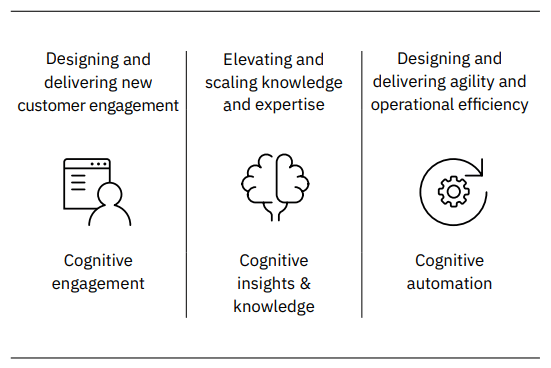
The Cognitive Model also considers how organizations gain advantages over their competition by having a strong digital foundation. Paired with cloud computing, data analytics, and the proper cybersecurity measures, implementing AI from a cognitive intelligence standpoint has proven to be a key accelerator of business outcomes and rapid growth.
The Result and Impact Grid
According to a study carried out by Deloitte, which reviewed close to 200 vendors and their clients, the value of AI in a business landscape can be mapped out following its type of result and type of impact on a 2×2 grid.
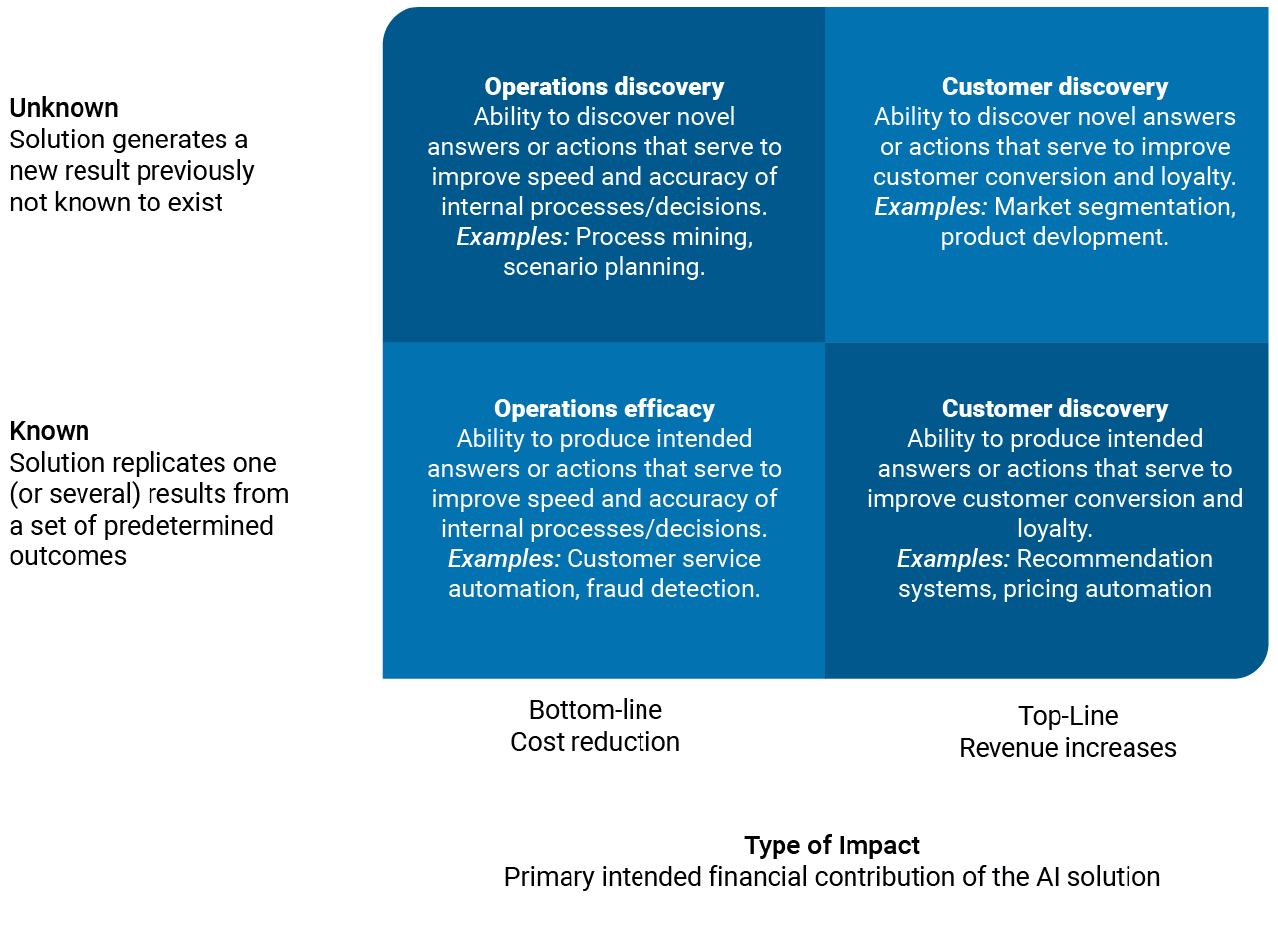
In this chart, the type of result axis is used to determine whether an AI produces known or unknown results.
- Known results are those retrieved by an AI from a previously determined set of data. A chatbot, for example, is an AI usually designed to produce known results. Whenever a customer sends a message, the chatbot will browse through its database and retrieve the most appropriate response following an existent set of rules. Whatever information such chatbot can give is already known by the company that owns it.
- Unknown results, on the contrary, occur when an AI creates new answers that can be turned into insights. Unknown results are the product of generative algorithms, which are capable of delivering new data based on a few given parameters. As an example, a Marketing Agency can use an AI to produce unknown results when segmenting customer groups following a set of characteristics. Before using the AI, the result was unknown to the agency.
The type of impact axis, on the other hand, distinguishes whether an AI delivers financial impact on the top or bottom line.
- Bottom-line impacts are a measure of net income improvements achieved through reducing costs. An example of this is when an AI reduces the need for hiring human staff to perform certain tasks, or when an AI boosts the quality and reliability of human work.
- Top-line impacts are defined as growth in revenue achieved by increasing the value of a company’s products and services from the customer’s perspective. As an example, an e-commerce website using an AI recommendation system will most likely increase its sales along with a better customer experience.
Of course, real-world AI applications will generate results that overlap throughout the 2×2 grid—especially as those solutions evolve over time. The goal of the Result and Impact Grid is merely to define clear starting points for organizations looking to measure the value of their AI implementations, as well as to direct the evolution and future goals of the AI application.
The Value Generation Cycle (VGC)
While both of the previous models are quite effective at guiding businesses on their AI journeys, we believe there is a better way to analyze the business value of artificial intelligence solutions. Our experience tells us that any AI business strategy must be targeted towards creating customizable automated and augmented services. This is achieved in two steps.
First, companies must understand how to provide customizable and scalable AI-driven experiences by capitalizing on data. This is done by tackling AI solutions from a cyclical perspective:
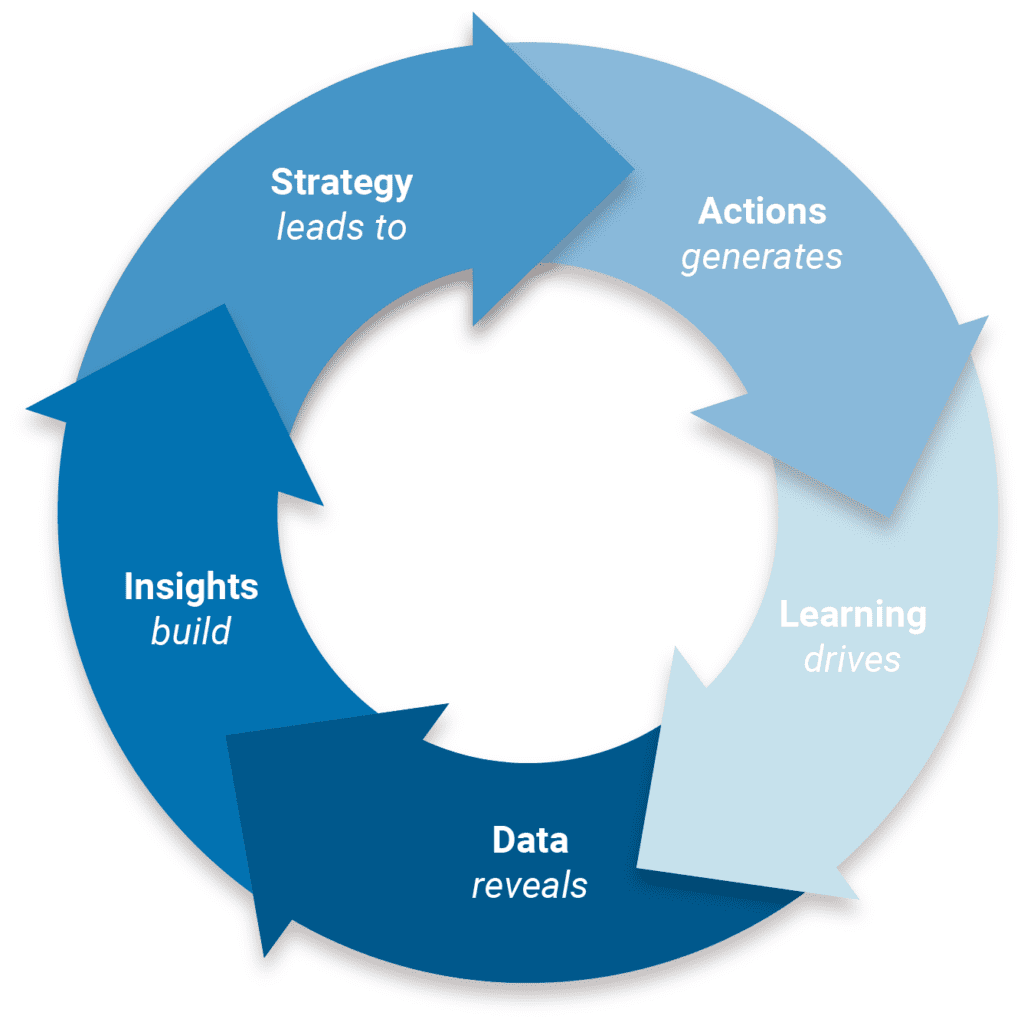
- DataThe rate at which we are producing information is staggering. By 2025, it’s estimated that 463 exabytes of data will be created on a daily basis—that is 1 billion gigabytes squared. It is impossible for a human to imagine all the insights such a massive amount of data contains. That is why AI must play a mediating role, cutting through this massive amounts of information that would otherwise be impossible to grasp. This way, it can bring our attention to hidden patterns and powerful insights.
- InsightsAs we said before, AI may bring us the patterns, but the real value lies on what we do with them. The critical role of AI is to identify causalities and drivers that predict outcomes any business can use to shape their decisions.
- StrategyOnce a business determines its key insights, it must implement them into their core strategy and define the ways it can generate the most value. We will dive deeper into this topic later on this whitepaper.
- ActionAfter setting the bases of the strategy, the groundwork is over, and it is time for action. This is where a company tests the performance of an AI solution on a real-world scenario.The AI runs all the calculations and makes all the decisions necessary to fulfill the goals it was programmed to achieve.
- LearningAfter performing an action and monitoring its own behavior, an AI will analyze its results and learn from them. The development team in charge of the algorithm will make sure this process remains in line with the company’s goals. It is also worth mentioning that, while this is a cyclical process, the learning stage doesn’t always lead back to more data. It can also lead straight to any other of its past stages, where it will once again generate new learning.
Defining Automation and Augmentation
Based on the principles of the Value Generation Cycle, we can identify the opportunities to generate business value on a dual axis plane.
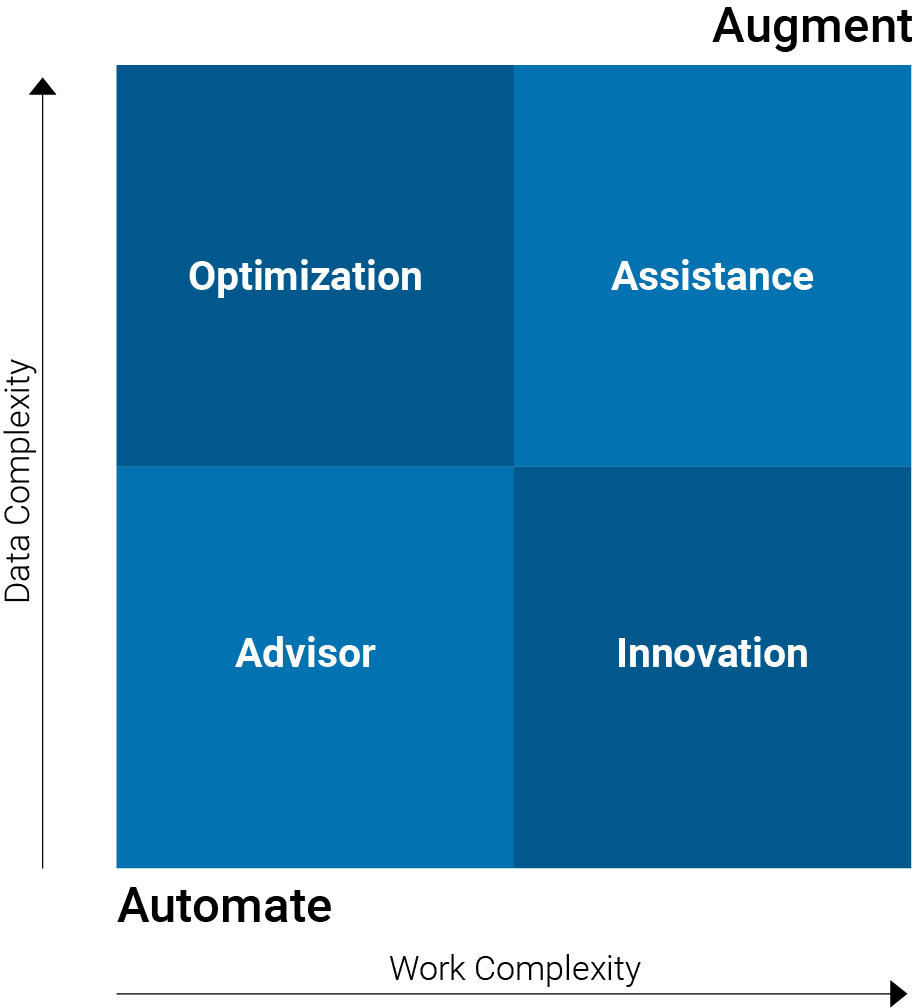
On the Y axis, we can find the Data Complexity, which can be determined based on the data set structure. For example, strings of code are linear and structured data that a computer can easily read, while images and videos are unstructured and much more complex.
The X axis represents the Work Complexity. This refers to how routinary and how many rules a type of work has to follow. The complexity is proportional to its predictability: the more rules and routines, the more it requires judgment, and the less predictable it becomes. For example, the process of a self-driving car making a left turn has a very high work complexity—the AI must follow many rules and judge whether or not it is safe to make the turn.
Based on these two axis, we can determine when AI should be used to automate and when AI should be used to augment. Automation removes humans from the process, while the goal of Augmentation is to enhance and complement human capabilities. This creates four areas in which we can identify the role of AI.
- OptimizationAny operation that deals with low amounts of data and work complexity can be easily automated. This is the goal most companies set at the beginning of their AI journey, since it is the easiest to identify, adopt, and implement. By optimizing processes with automation, operations become more efficient and their cost is significantly reduced.
- AssistanceWhen the work is simple but it deals with large amounts of data, AI is better suited to fulfill the role of an assistant rather than becoming a full replacement. This means enhancing the communication and coordination capabilities of the people involved and adding value to their work by making it more effective. Common types of assistance are scheduling, messaging, and monitoring.
- AdvisorCombining simple data with high work complexity means that there will be a lot of judgement in the way—which computers are not so good at. Here, AI takes on a supportive role and leaves all decisions to humans, who just act upon the information given by the machine. This is what happens when an AI suggests a medical treatment or an investment opportunity.
- InnovationHigh data and work complexity might sound like a hard day’s work, but it is also the breeding ground for innovative solutions. In this context, humans and AI work together to devise original, creative work through a lot of experimentation, exploration, and lateral thinking. Some examples of this are AI music composition, alternative text writing, or even suggested improvements to a corporations’ value chain.
- LearningAfter performing an action and monitoring its own behavior, an AI will analyze its results and learn from them. The development team in charge of the algorithm will make sure this process remains in line with the company’s goals. It is also worth mentioning that, while this is a cyclical process, the learning stage doesn’t always lead back to more data. It can also lead straight to any other of its past stages, where it will once again generate new learning.
Following this dual axis plane, any company can easily identify how AI can provide value to their company and begin to measure it. If you are not sure of how to place your AI project into the plane, try to split it into smaller pieces with more specific goals. How a company uses this or any of the other models mentioned before will provide unique results and ideas for value creation.
Implementing a Value-Oriented AI Business Strategy
Any successful AI strategy has a thorough focus on generating value for the company. Implementing it, however, requires more than software tools, resources, and talent. Just like any business strategy, implementation begins with putting the intangible fundamentals in place. The three main ones are proving how AI can provide value, getting leadership support, and spreading an adoption culture.
-
Proving the Value of AI
To prove the value of AI it is fundamental to determine exactly where and how it could be used. This is what organizations often define as a “business case” – a clear proposal that details the returns of an investment and justifies it. This way, an AI strategy should start out as any other business project: by targeting and solving a business problem. And since AI solutions are flexible and scalable, it shouldn’t be hard to see how it can tackle other business problems in the near future.
This step is key to getting the right stakeholders on board and make sure that the project will not easily fall apart. However, AI solutions can often seem costly and risky, and the immediate gains might be hard to see. If that’s the case, it’s better to start small and get some wins before scaling the long-term project. This will make it easier to get other people’s support and prevent the company from getting buried by a more risk-taking competitor.
-
Getting Leadership Support
Business leaders are drivers of change, and without their support any AI strategy is bound to fail. That’s even if the business case has already been established and the value of AI has been proven. The support of the leadership team must be active and show vision and tenacity in shaping the AI strategy.
Receiving project validation from the leadership team is a key element to build trust across every involved party. As a consequence, the strategy can acquire a holistic trait, rather than being seen as a one-time solution with no long term impact.
It is also critical to designate a project leader, who will be in charge of driving and implementing the AI strategy. This leader must cooperate with the general leadership team to encourage adoption and show commitment to the project, even if results are scarce at the beginning. Having the patience and determination to overcome obstacles will inspire the rest of the team as the project gains momentum.
-
Adopting the AI Culture
Even if leaders support and understand the benefits of AI for the business, employees are also a fundamental part of the equation who will probably come into contact with the technology on a daily basis. They need to be willing to use the technology and get the most out of it. That is why adopting a positive mindset is a priority for any AI strategy.
On the other side, teams should also be prepared to face the uncertainties, failures, and frustrations that may come with AI projects. In these cases, getting support from an IT consultant is always an option, especially if the in-house teams can get some first-hand experience from outsourced teams. The bottom line is that a successful AI strategy requires the entire organization to be onboard.
The Key Takeaway
The era of Artificial Intelligence is upon us. It is evident that AI has already begun to create a tangible value in most (if not all) industries. The transformative capabilities that AI provides for businesses looking to gain a competitive advantage is undeniable—which means that the sooner an organization adopts the technology, the better. Any business that decides to understand and implement AI will be able to shape the value generated by their AI strategy as needed.
For those who have still not begun their artificial intelligence journey, the time to act is now. Accessing data is the key of everything. As long as a business is able to determine the type, quantity, and quality of data required to achieve its objectives, finding relevant use cases to pursue shouldn’t be hard. Otherwise, getting data from other public sources or partnering with an IT Outsourcing Company can help with achieving long term goals.
And for those looking to take the next step, don’t be afraid of failure. Even though many AI projects can be particularly challenging, require interdisciplinary collaboration, and bear high cost and time investments, achieving success is well worth it. Remember: failure is an integral part of innovation—and that is the basis of any Artificial Intelligence algorithm.
If you enjoyed this, be sure to check out our other AI articles.


